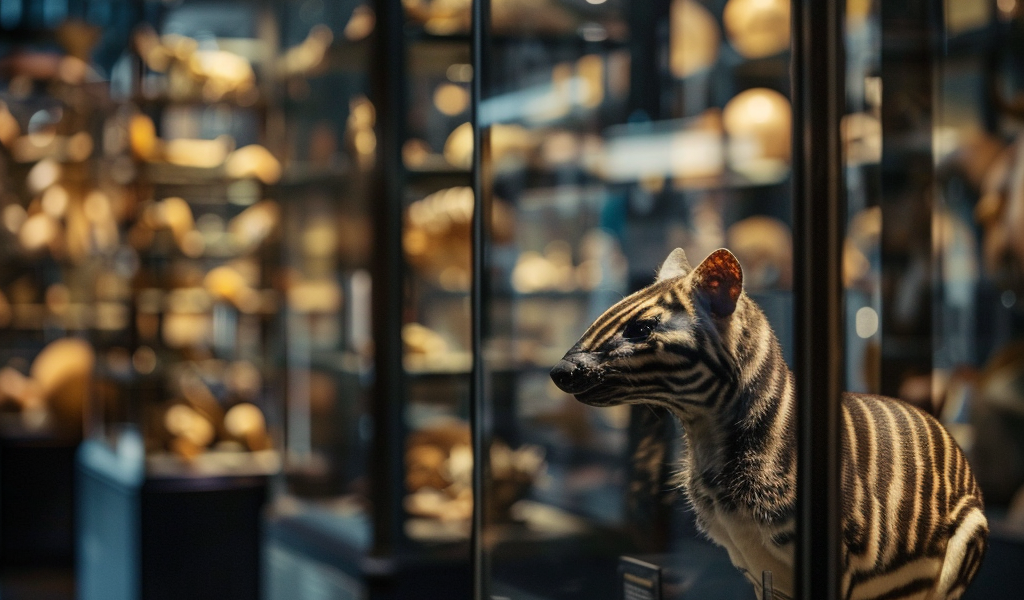In a remarkable turn of events, researchers have discovered a well-preserved thylacine head in a Melbourne museum, sparking new hope in the quest to resurrect the extinct Tasmanian tiger. The thylacine, which went extinct in 1936, has long been a subject of fascination for scientists and conservationists alike. This unexpected find has provided crucial genetic material that could play a pivotal role in the ambitious project to bring this iconic marsupial back to life.
The extraordinary specimen was found in a bucket of ethanol, tucked away in a forgotten corner of the museum. Professor Andrew Pask, who leads the Thylacine Integrated Genetic Restoration Research (TIGRR) lab at the University of Melbourne, described the initial discovery as both shocking and gruesome. “It was literally a head in a bucket of ethanol… sitting there for about 110 years,” he recounted. “It was pretty putrid, a completely gruesome sight. People had chopped large chunks off it.” Despite its unpleasant appearance, the specimen was a treasure trove of genetic information, containing long RNA molecules that scientists believed would be impossible to obtain.
One year after this serendipitous find, the research team has made significant progress in their efforts to reconstruct the thylacine genome. Professor Pask noted, “We are further along than I thought we would be, and we have completed a lot of things that we thought would be very challenging and others said would be impossible.” This advancement is a testament to the potential of modern genetic engineering techniques and the dedication of scientists committed to de-extinction efforts.
The initiative to revive the thylacine is primarily spearheaded by Colossal, a Texas-based biotechnology company that specializes in de-extinction and species preservation. Colossal is not only focused on the thylacine but is also working on recreating other extinct species, such as the woolly mammoth and the dodo. The company utilizes cutting-edge genetic engineering methods to explore the possibilities of bringing these long-lost animals back to life.
Entrepreneur Ben Lamm, who leads Colossal, has expressed enthusiasm about the project. The company aims to combine advanced genetic techniques with the genetic material retrieved from the thylacine specimen to create a living version of the species. This endeavor has garnered attention and support from various scientific communities, highlighting the intersection of technology, conservation, and ethical considerations surrounding de-extinction.
The thylacine, once native to Tasmania, was a unique carnivorous marsupial that resembled a large dog with distinctive stripes on its back. Its extinction is attributed to a combination of hunting, habitat loss, and disease. As a cultural icon of Australia, the thylacine has left a lasting legacy, and many conservationists believe that its revival could serve as a powerful symbol for wildlife conservation efforts worldwide.
While the prospect of bringing the thylacine back to life is exciting, it also raises important questions about the ethical implications of de-extinction. Scientists must consider the ecological impact of reintroducing a species that has been absent from its habitat for nearly a century. Additionally, the potential for unforeseen consequences in ecosystems that have evolved without the thylacine poses challenges that researchers must navigate carefully.
As the project progresses, the collaboration between Australian and US scientists continues to strengthen, with shared expertise and resources driving the research forward. The discovery of the thylacine head has not only provided valuable genetic material but has also reinvigorated interest in the species and the broader conversation about biodiversity and conservation.
In the coming years, the team hopes to achieve further breakthroughs in genetic reconstruction, ultimately leading to the birth of a living thylacine. This ambitious goal represents a significant leap in the field of genetic engineering and serves as a reminder of the power of science to challenge the boundaries of what is possible.
As the world watches this groundbreaking project unfold, it stands as a testament to human ingenuity and the relentless pursuit of knowledge. The story of the thylacine may not just end with its extinction; instead, it could mark the beginning of a new chapter in conservation history, one where lost species can be resurrected through the marvels of modern science.





